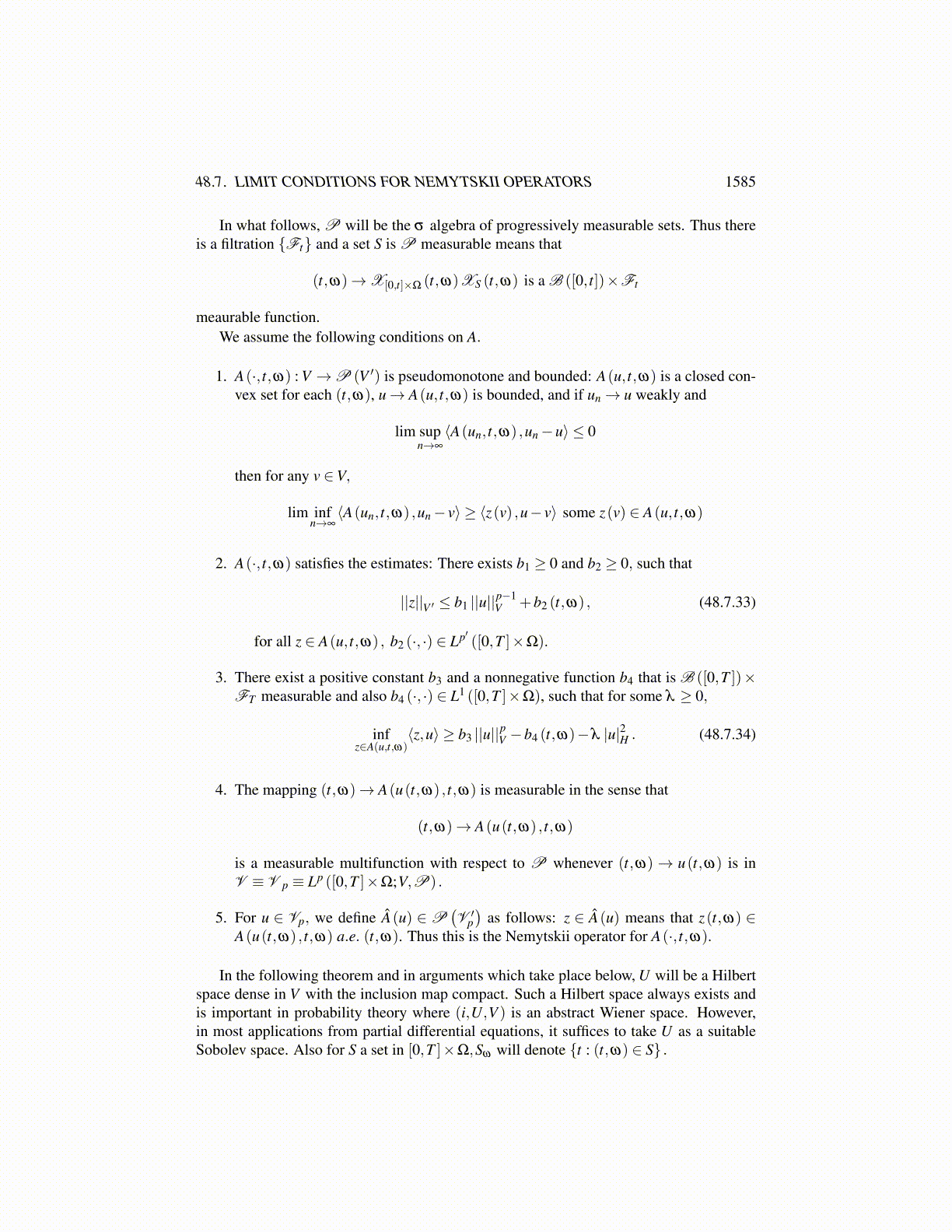
48.7. LIMIT CONDITIONS FOR NEMYTSKII OPERATORS 1585
which then satisfies F (t) ̸= /0. Now F (t) is closed and convex in V ′.Claim: t→ F (t) has a measurable selection off a set of measure zero.Proof of claim: Letting B(0,C (t)) contain A(u(t) , t) , we can assume t → C (t) is
measurable by using the estimates and the measurability of u. For p∈N, let Sp be given by{t : C (t)< p}. If it is shown that F has a measurable selection on Sp, then it follows that ithas a measurable selection. Thus in what follows, assume that t ∈ Sp.
Define
G(t)≡{
w : ⟨w,u(t)− y(t)⟩< α (t)+1n
, t /∈ Σ
}∩B(0, p)
Thus, it was shown above that this G(t) ̸= /0. For U open,
G− (U)≡{
t ∈ Sp : for some w ∈U ∩B(0, p) ,⟨w,u(t)− y(t)⟩< α (t)+1n
}(*)
Let{
w j}
be a dense subset of U ∩B(0, p). This is possible because V ′ is separable. Theexpression in ∗ equals
∪∞k=1
{t ∈ Sp : ⟨wk,u(t)− y(t)⟩< α (t)+
1n
}which is measurable. Thus G is a measurable multifunction.
Since t → G(t) is measurable, there is a sequence {wn (t)} of measurable functionssuch that ∪∞
n=1wn (t) equals
G(t) ={
w : ⟨w,u(t)− y(t)⟩ ≤ α (t)+1n
, t /∈ Σ
}∩B(0, p)
As shown above, there exists wt in A(u(t) , t) as well as G(t) . Thus there is a sequenceof wr (t) converging to wt . Since t → A(u(t) , t) is a measurable multifunction, it has acountable subset of measurable functions {zm (t)} which is dense in A(u(t) , t). Let
Uk (t)≡ ∪mB(
zm (t) ,1k
)⊆ A(u(t) , t)+B
(0,
2k
)Now define A1k = {t : w1 (t) ∈Uk (t)} . Then let A2k = {t /∈ A1k : w2 (t) ∈Uk (t)} and
A3k ={
t /∈ ∪2i=1Aik : w3 (t) ∈Uk (t)
}and so forth. Any t ∈ Sp must be contained in one
of these Ark for some r since if not so, there would not be a sequence wr (t) convergingto wt ∈ A(u(t) , t). These Arp partition Sp and each is measurable since the {zk (t)} aremeasurable. Let
ŵk (t)≡∞
∑r=1
XArk (t)wr (t)
Thus ŵk (t) is in Uk (t) for all t ∈ Sp and equals exactly one of the wm (t) ∈ G(t).Also, by construction, the ŵk (·) are bounded in L∞ (Sp;V ′). Therefore, there is a subse-
quence of these, still called ŵk which converges weakly to a function w in L2 (Sp;V ′) .
Thus w is a weak limit point of co(∪∞
j=kŵ j
)for each k. Therefore, in the open ball